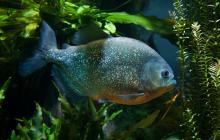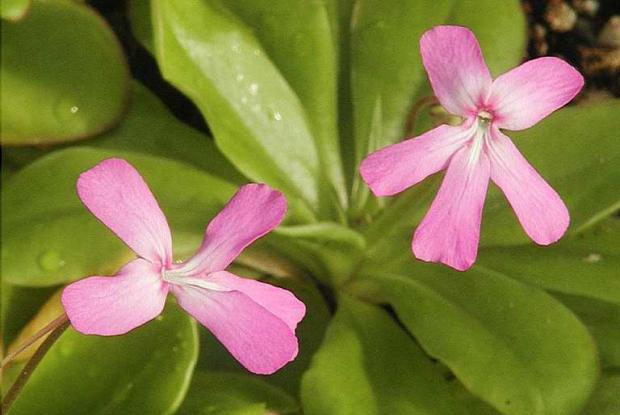There are 40 known species in the genus Pinguicula, most of them in the Northern Hemisphere. The plant has a rosette of sessile leaves, more or less elliptical. The blades are generally flat, but the margins, most often complete, curve upward. The are covered with a sticky mucilage that, along with the slightly fleshy nature of the glandular tissue, gives the plant a somewhat greasy feel – hence its name. Its French name is grassette, for the same reasons. The scientific name also refers to this characteristic, as the Latin word pinguis means fat. The flower stalk bears a single pentamerous (five-part) flower; the petals are partially joined together at the base. The genus Pinguicula is represented in Québec by 2 species.
The trap
The leaf is covered with 2 types of glands. The peduncular glands, barely visible to the naked eye, produce droplets of clear mucilage that make the leaf appear to glisten in the sun. Their primary purpose is to entrap and hold prey. The microscopic sessile glands, located in slight depressions in the leaf, are responsible for digestion and absorption. The plant rarely catches insects larger than a housefly, but makes up for it by trapping many of them. Just as with Drosera, insects that alight or walk on the leaf gradually become stuck. As they struggle to free themselves, they unfortunately become further entrapped by a larger number of glands. The presence of the captured prey activates the secretion of digestive enzymes by the sessile glands. These glands absorb the resulting nutrient fluid. For larger prey, the leaf edges curl around it, bringing it into contact with more glands. This also reduces the likelihood of rain washing away the nutrients, as is also the case for Drosera rotundifolia.
It usually takes at least 2 days to curl and uncurl a leaf edge, however, so it is easy to see why it plays no role in actually capturing prey.
Species
Pinguicula vulgaris Linnaeus
- Common name: Common butterwort
- French name: Grassette vulgaire
- Description: Oblong leaves forming a rosette up to 11 cm across. Each of the 2 or 3 hairless floral stalks that emerge from the rosette bears a single purple flower with a 2 lips and a spur, and a white spot in the centre.
- Habitat: Very moist and highly calcareous sites, wet rocks, marshy shorelines
- Distribution in Québec: Widespread
- Global distribution: North America, Europe and Siberia
Pinguicula villosa Linnaeus
- Common name: Hairy butterwort
- French name: Grassette velue
- Description: Obovate leaves. Rosette measuring 2 to 3 cm across, bearing up to 3 hairy flower stalks. Flowers pale blue to purple, with faint yellow veins.
- Habitat: Swamps or moist ledges, around ponds or in peat bogs
- Distribution in Québec: Throughout the north starting from Lac Mistassini
- Global distribution: Canada, Europe, Siberia







